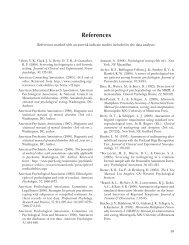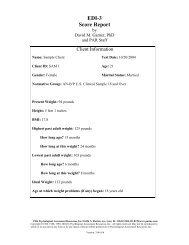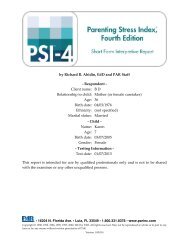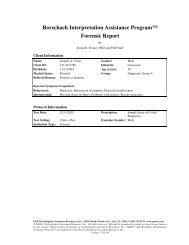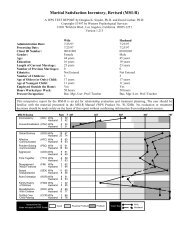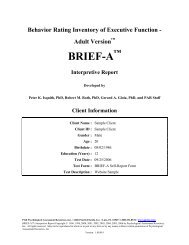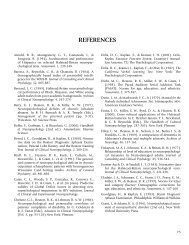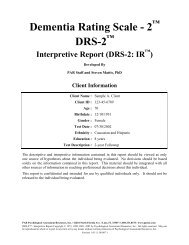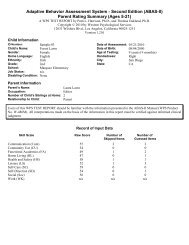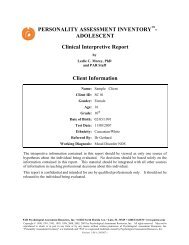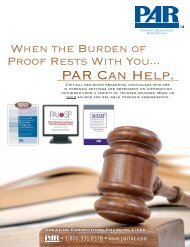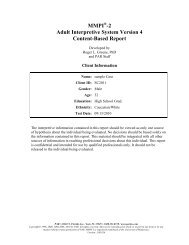WRAT4-PMV Bibliography - Psychological Assessment Resources ...
WRAT4-PMV Bibliography - Psychological Assessment Resources ...
WRAT4-PMV Bibliography - Psychological Assessment Resources ...
You also want an ePaper? Increase the reach of your titles
YUMPU automatically turns print PDFs into web optimized ePapers that Google loves.
HOSTS Learning (2004). Scientifically-based core curriculumand supplemental materials: The readingcenteredschool. Vancouver, WA: Author.Individuals with Disabilities Education Improvement Actof 2004 (IDEA) (2004). Public Law No. 108-446,§632, 118 Stat. 2744.Kamphaus, R. W. (1993). Clinical assessment of children’sintelligence: A handbook for professional practice.Boston: Allyn & Bacon.Kaufman, A. S., & Kaufman, N. L. (2004). Kaufman Testof Educational Achievement–Second Edition Compre -hensive Form. Circle Pines, MN: American GuidanceService.Kaufman, A. S., & Kaufman, N. L. (2005). Kaufman Testof Educational Achievement–Second Edition BriefForm. Circle Pines, MN: American Guidance Service.Lord, F. M. (1980). Applications of item response theoryto practical testing problems. Mahwah, NJ: Erlbaum.Lord, F. M., & Novick, M. R. (1968). Statistical theoriesof mental test scores. Reading, MA: Addison-Wesley.Matarazzo, J. D. (1990). <strong>Psychological</strong> assessment versuspsychological testing: Validation from Binet to theschool, clinic, and courtroom. American Psychologist,45, 999-1017.McGrew, K. S., & Woodcock, R. W. (2001). Technicalmanual Woodcock-Johnson III. Itasca, IL: RiversidePublishing.Messick, S. (1989). Validity. In R. L. Linn (Ed.),Educational measurement (3rd ed., pp. 13-104). NewYork: American Council on Education and MacmillanPublishing.Messick, S. (1995). Validity of psychological assessment:Validation of inferences from person’sresponses and performances as scientific inquiry intoscore meaning. American Psychologist, 50, 741-749.Mish, F. C. (Ed.). (2004). Merriam-Webster’s collegiatedictionary (11th ed.). Springfield, MA: Merriam-Webster.No Child Left Behind (NCLB) Act (2002). Public LawNo. 107-110, 20 U.S.C. 6301 et. seq.President’s Commission on Excellence in SpecialEducation. (2002). A new era: Revitalizing specialeducation for children and their families. Washington,DC: U.S. Department of Education.Rasch, G. (1980). Probabilistic models for some intelligenceand attainment tests. Chicago: University ofChicago Press.Reynolds, C. R., & Kamphaus, R. W. (2003). ReynoldsIntellectual <strong>Assessment</strong> Scales. Lutz, FL: Psychologi -cal <strong>Assessment</strong> <strong>Resources</strong>.Robertson, G. J. (2001). Wide Range Achievement Test–Expanded Edition. Wilmington, DE: Wide Range.Roid, G. H. (2003). Stanford-Binet Intelligence Scale (5thed.). Itasca, IL: Riverside.Roid, G. H. (2004). Quality of performance and changesensitiveassessment of cognitive ability. Proceedingsof the International Test Users Conference (Keynoteaddress). Melbourne, Australia: Australian Centre forEducational Research.Sattler, J. M. (1988). <strong>Assessment</strong> of children (3rd ed.).San Diego, CA: Author.Shinn, M. R. (Ed.). (1989). Curriculum-based measurement:Assessing special children. New York: Guilford.Shinn, M. R. (Ed.). (1998). Advanced applications ofcurriculum-based measurement. New York: Guilford.Shinn, M. R., & Bamonto, S. (1998). Advanced applicationsof curriculum-based measurement: “Big ideas”and avoiding confusion. In M. R. Shinn (Ed.)Advanced applications of curriculum-based measurement(pp. 1-31). New York: Guilford.Spache, G. (1953). A new readability formula for primarygradereading materials. Elementary School Journal,63, 410-413.Spellings, M. (2005). No Child Left Behind: A road mapfor state implementation. Washington, DC: U.S.Department of Education.Stein, J. (Ed.). (1980). The Random House college dictionary(rev. ed.). New York: Random House.Stuebing, K. K., Fletcher, J. M., LeDoux, J. M., Lyon,G. R., Shaywitz, S. E., & Shaywitz, B. A. (2002).Validity of IQ discrepancy classifications of readingdisabilities: A meta-analysis. American EducationalResearch Journal, 39, 469-518.Taylor, S. E., Frackenpohl, H., White, C. E., Nieroroda,B. W., Browning, C. L., & Birsner, E. P. (1989). EDLcore vocabularies in reading, mathematics, science,and social studies: A revised core vocabulary. Austin,TX: Steck-Vaughn.Taylor, W. L. (1953). “Cloze procedure:” A new tool formeasuring readability. Journalism Quarterly, 30,415-433.The <strong>Psychological</strong> Corporation (2001). WechslerIndividual Achievement Test: Second Edition:Examiner’s manual. San Antonio, TX: Author.84
Tindal, G., Fuchs, L. S., Fuchs, D., Shinn, M. R., Deno, S.,& Germann, G. (1985). Empirical validation of criterion-referencedtests. Journal of EducationalResearch, 78, 203-209.Torgesen, J., Rose, E., Lindamood, P., Conway, T., &Garvan, C. (1999). Preventing reading failure in youngchildren with phonological processing disabilities:Group and individual responses to instruction. Journalof Educational Psychology, 91, 579-594.Turner, S. M., DeMers, S. T., Fox, H. R., & Reed, G.(2001). APA’s guidelines for test user qualifications:An executive summary. American Psychologist, 56,1099-1113.U.S. Bureau of the Census. (2001). Current populationsurvey, March 2001 [Data file]. Washington, DC: U.S.Department of Commerce.Vaughn, S., & Fuchs, L. S. (2003). Redefining learningdisabilities as inadequate response to instruction: Thepromise and potential problems. Learning DisabilitiesResearch and Practice, 18, 137-146.Vaughn, S., Linan-Thompson, S., & Hickman, P. (2003).Response to instruction as a means of identifying studentswith reading/learning disabilities. ExceptionalChildren, 69(4), 391-409.Wechsler, D. (1939). Wechsler-Bellevue IntelligenceScales. New York: The <strong>Psychological</strong> Corporation.Weiss, D. J. (1982). Improving measurement quality andefficiency with adaptive testing. Applied Psycho -logical Measurement, 6, 473-492.Wilkinson, G. S. (1993). Wide Range Achievement Test–Third Edition. Wilmington, DE: Wide Range.Wilkinson, G. S., & Robertson, G. J. (2006). <strong>WRAT4</strong>Wide Range Achievement Test professional manual(4th ed.). Lutz, FL: <strong>Psychological</strong> <strong>Assessment</strong><strong>Resources</strong>.Wilks, S. S. (1946). Sample criteria for testing equality ofmeans, equality of variances, and equality of covariancesin a normal multivariate distribution. The Annalsof Mathematical Statistics, 17, 257-281.Woodcock, R. W., & Dahl, M. N. (1971). A commonscale for the measurement of person ability and testitem difficulty (AGS Paper No. 10). Circle Pines, MN:American Guidance Service.Woodcock, R. W., McGrew, K. S., & Mather, N. (2001).Woodcock-Johnson III Tests of Achievement. Itasca,IL: Riverside.Wright, B. D., & Linacre, J. M. (1995). BIGSTEPSRasch-Model computer program (Version 2.57).Chicago: MESA Press.Wright, B. D., & Linacre, J. M. (1999). WINSTEPS:Rasch analysis for all two-facet models. Chicago:MESA Press.Wright, B. D., & Stone, M. H. (1979). Best test design.Chicago: MESA Press.85



